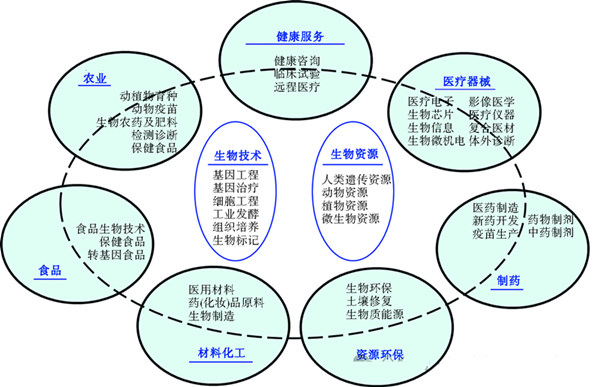
The Chinese bioeconomy, with biotechnology and biological resources as its two core perspectives, covers multiple fields such as agriculture, food, pharmaceuticals, medical devices, health services, resource and environmental protection, and materials and chemicals. It is expected that by 2035, the scale of China's bioeconomy will reach 38 trillion to 50 trillion yuan.
Since the 21st century, with the accelerated breakthroughs in life sciences and modern biotechnology, the beautiful development blueprint of the bioeconomy has been constantly updated and iterated, especially in addressing major challenges facing humanity such as climate change, food security, energy independence, and environmental sustainability. In recent years, more and more application scenarios have accelerated from paper-based blueprints to reality, and technological updates and breakthroughs have entered a stage of rapid development. The era of bioeconomy is accelerating.
In recent years, a global systemic change characterized by the value of biological resources and the industrialization of biotechnology is taking place. More and more opinions believe that the potential of biotechnology in the future may determine what people eat, wear, use, and even the way they build the world. It will greatly change the mode of material production and human lifestyle, becoming an economic form corresponding to agricultural economy, industrial economy, and digital economy. A research report by McKinsey&Company suggests that approximately 60% of physical inputs in global economic development can theoretically be produced through biotechnology. Although there is still a long way to go to achieve the vision goals, even if some progress is made, it will gradually change the supply and demand relationship, industrial structure, and consumer behavior.
The two main perspectives of bioeconomy are based on life sciences, modern biotechnology, and innovation. The other type is based on the perspective of biological resources, emphasizing renewability and sustainability.
The United States, the European Union, Japan, South Korea, Argentina, India, Malaysia, South Africa and other countries have listed bioenergy, bioenvironment, bioinformatics and other fields as priority areas for development, in order to drive rural and social development based on their comparative advantages, further create employment and economic growth, enhance international competitiveness, and achieve national and sustainable development through biotechnology.
Since the concept of bioeconomy was proposed, some market consulting agencies and government departments in some countries and regions have begun to predict the impact of bioeconomy, measure the market size and driving role of bioeconomy. At present, there are four main methods. The first method is the case study based on application scenarios. The second method is based on establishing a "satellite account" statistical approach. The third method is based on input-output (I-O) measurement. The fourth method is based on big data analysis.
Since the 11th Five Year Plan period, China has vigorously supported the development of the biotechnology industry with the aim of promoting its industrialization. At that time, based on the stage and characteristics of industrial development, the biotechnology industry mainly included seven directions: biopharmaceutical industry, biomedical engineering industry, bio agriculture, bio energy industry, bio manufacturing industry, bio environmental protection industry, and bio service industry, fully reflecting the technological innovation, resource utilization, and integration empowerment attributes of the bioeconomy.
Based on data from 2021, the scale of the biopharmaceutical economic system is approximately 4 trillion yuan, accounting for about 19% of the total scale; The scale of the bio agricultural economic system is about 9.9 trillion yuan, accounting for about 47% of the total scale; The scale of the biomanufacturing economic system is about 6.9 trillion yuan, accounting for about 33% of the total scale; The scale of the "bio+" economic system is currently negligible, but its impact in the future is enormous. Overall, the total scale of China's bioeconomy in 2021 is about 20.8 trillion yuan, with a structure ratio of 19:47:33 for pharmaceuticals, agriculture, and manufacturing. Based on this, analyze the total scale of China's bioeconomy in three scenarios: conservative, steady, and optimistic, and predict it for 2027 and 2035.
In a conservative scenario, it is expected that the growth of the bioeconomy will basically keep pace with economic development. Based on an average annual growth rate of 7%, the scale of biopharmaceuticals is projected to reach 6 trillion yuan and 10 trillion yuan by 2027 and 2035, respectively; Based on an average annual growth rate of 2%, the scale of bio agriculture is expected to reach 11.2 trillion yuan and 13.1 trillion yuan by 2027 and 2035, respectively; By maintaining a growth rate of around 5% and increasing the substitution rate of related industries to 10% and 20% respectively, the scale of biomanufacturing is estimated to exceed 10 trillion yuan and 15 trillion yuan by 2027 and 2035, respectively. The total scale of China's bioeconomy is expected to reach 27.2 trillion yuan and 38.1 trillion yuan, respectively. In a stable situation, the demand for "Healthy China" and "Beautiful China" is further expanding, and it is expected that the growth rate of the bioeconomy will be slightly higher than the economic development rate. The growth rates of biopharmaceuticals, bio agriculture, and bio manufacturing are estimated to be around 8%, 3%, and 6% respectively. By 2027, the scale of the bioeconomy will reach 30 trillion yuan, close to 1/4 of the gross domestic product, and by 2035, it will exceed 40 trillion yuan. In an optimistic scenario, the impact of carbon neutrality and peak carbon policies exceeds expectations, and the potential of the biomanufacturing market is expected to expand rapidly, increasing the substitution rate of biomanufacturing related industries to 30% to 40%. Combined with the continuous maturity of the "bio+" economic system, it is estimated that the scale of the biomanufacturing economy will exceed 50 trillion yuan by 2035.
Content collected and organized from the internet. If there is any infringement, please contact us for deletion